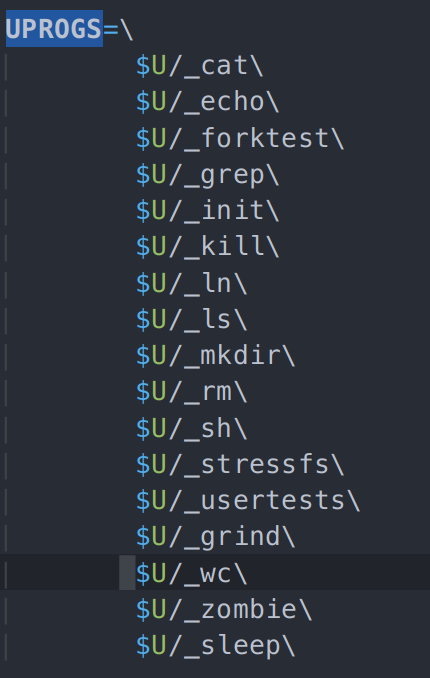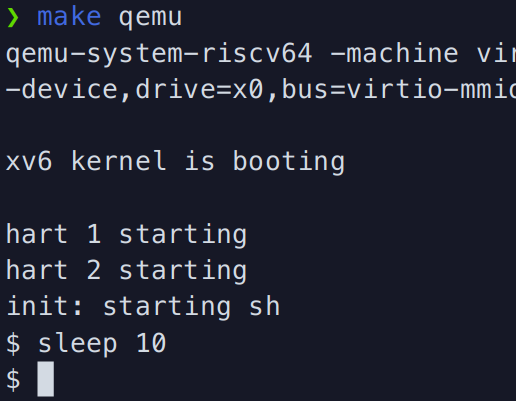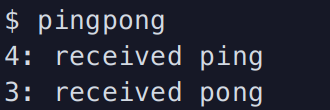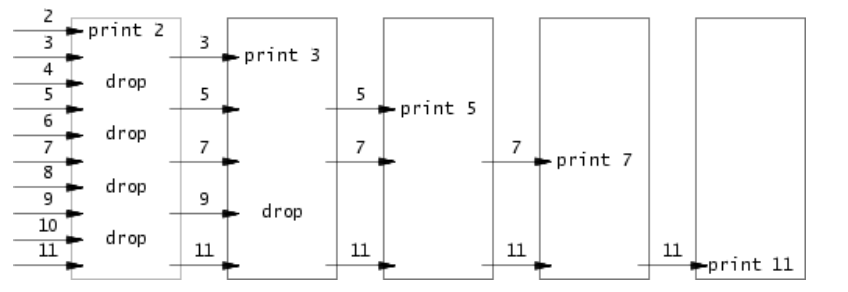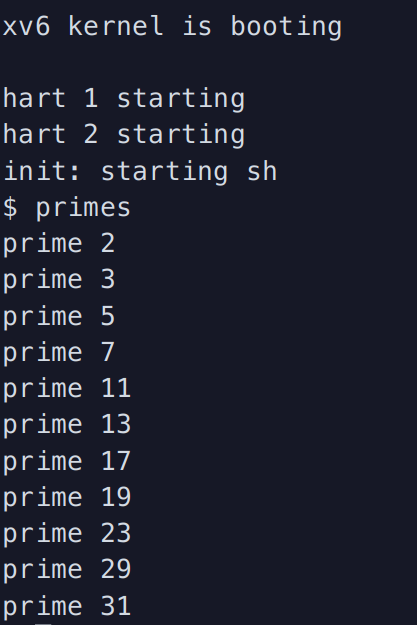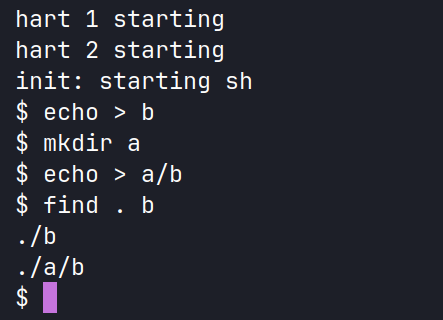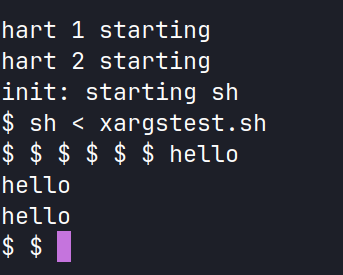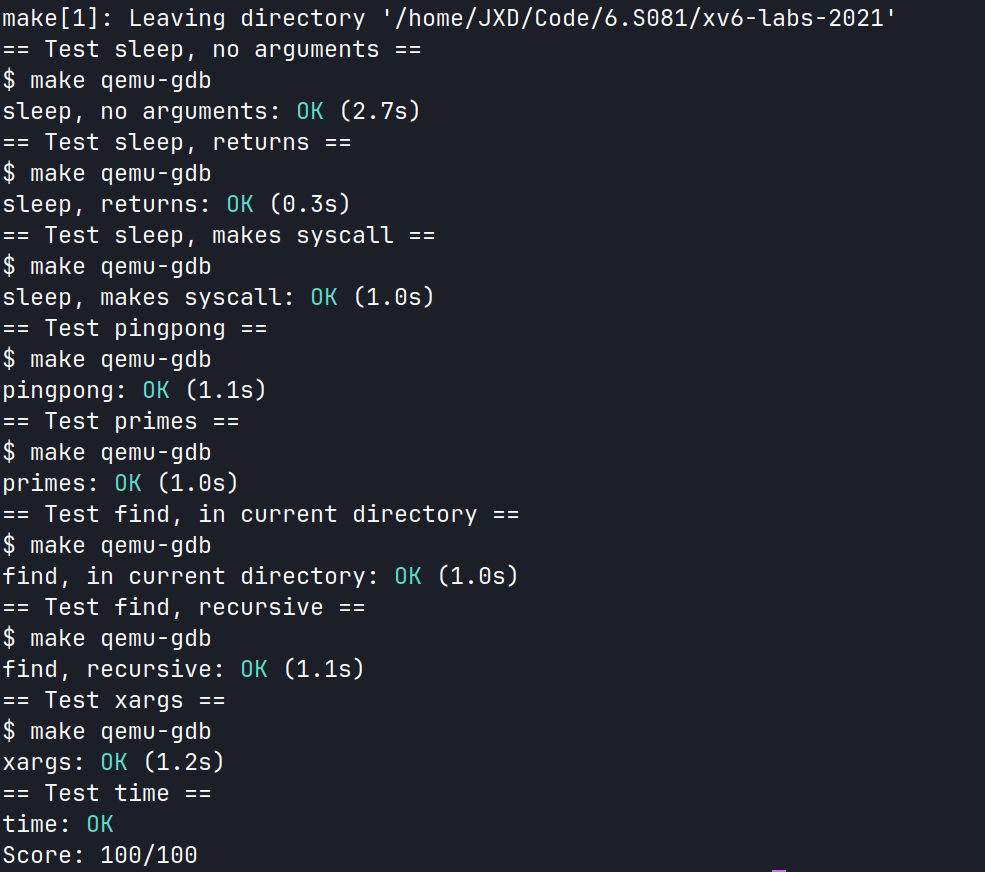前置准备
主要内容为如何使用已有的系统调用编写用户程序, 例如ls、xargs、find等常用命令的实现。
根据课程官网的要求,需要看完Lecture 1,阅读完教材第一章$Operation \space System \space interfaces$。
此外,实验手册中的Hints很重要,大多数实验跟着提示一步一步实现都能完成。
Sleep (easy)
Statement
为xv6实现 $UNIX$ 中的sleep程序。sleep程序应该暂定用户指定的tick数量。tick是xv6内核定义的时间概念,即定时器两次中断之间的间隔时间。你的solution应该存储在user/sleep.c文件下。
Hints
在开始实现前,确保你阅读了xv6 book的第一章。
查看其他xv6中实现的其他用户程序(例如user/echo.c、user/grep.c、user/rm.c),了解如何从终端传递参数到程序中。
如果用户忘记传递参数,sleep应该显示错误消息并中断。
终端参数作为字符串传递,你需要用atoi(在user/ulib.c中实现)将其转换为int类型。
使用sleep系统调用。
有关实现sleep系统调用(见sys_sleep)的 xv6 内核代码,请参见 kernel/sysproc.c。有关可从用户程序调用sleep系统调用的 C 语言定义,请参见user/user.h;有关从用户代码跳转到内核中sleep的汇编代码,请参见 user/usys.S。
确保main函数中使用exit()来退出程序。
将sleep.c添加到Makefile的 UPROGS 中;完成后,在终端输入 make qemu 来编译你的程序,你就可以在 xv6 shell 中运行它了。
Analysis & Solution
首先按照Hint-1的提示看一眼user/echo.c是什么,可以看到下面的一段代码:
1 2 3 4 5 6 7 8 9 10 11 12 13 14 15 16 17 #include "kernel/types.h" #include "kernel/stat.h" #include "user/user.h" int main (int argc, char * argv[]) {int i;for (i = 1 ; i < argc; i++) {1 , argv[i], strlen (argv[i]));if (i + 1 < argc) {1 , " " , 1 );else {1 , "\n" , 1 );exit (0 );
argc存储终端传入的参数数量,argv存储传入的参数的具体内容。
于是可以写出下面的代码:
1 2 3 4 5 6 7 8 9 10 11 12 13 14 #include "kernel/types.h" #include "kernel/stat.h" #include "user/user.h" int main (int argc, char * argv[]) {if (argc != 2 ) {fprintf (2 , "Usage: sleep <ticks>\n" );exit (1 );int time = atoi(argv[1 ]);exit (0 );
然后在Makefile中的UPROGS添加一行$U/_sleep\,
运行qemu make,编译完成后输入sleep 10, 可以看到成功运行。
运行./grade-lab-util sleep测试一下。
PingPong (easy)
Statement
编写一个程序,使用 UNIX 系统调用在两个进程之间通过一对管道 “ping-pong” 传送一个字节,每个方向发送一次。 父进程应向子进程发送一个字节,子进程应打印<pid>: received ping(<pid>是其进程 ID),并将一个字节写入父进程的管道,然后退出;父进程应从子进程读取该字节,打印<pid>: received pong,然后退出。您的解决方案应放在 user/pingpong.c 文件中。
Hints
使用pipe创建管道
使用fork创建子进程
使用read来向管道中的读取端读取数据,write来向管道中的写入端写入数据。
使用getpid来获取当前进程的PID。
添加程序到Makefile里的UPROGS
xv6的用户程序可以使用有限的库函数,列出在user/user.h中。源代码(包括其他的系统调用)在user/ulib.c、user/printf.c、user/umalloc.c。
Analysis & Solution
和书上1.3的例子差不多,用大小为2的数组创建管道,其中p[0]是读取端,p[1]是写入端,然后fork分别发送读取。
write和read的第二个参数是一个地址,用char存储的话需要取地址,用char[]就没这么多事了。
需要注意的是,子进程和父进程的文件描述符是一样的,但并不是引用,在父进程关闭fd不会影响子进程。
1 2 3 4 5 6 7 8 9 10 11 12 13 14 15 16 17 18 19 20 21 22 23 24 25 26 27 28 29 30 31 32 33 34 35 36 #include "kernel/types.h" #include "kernel/stat.h" #include "user/user.h" int main (int argc, char * argv[]) {int p[2 ];char msg[2 ] = "@" ;char buf[2 ];if (fork() != 0 ) {if (write(p[1 ], msg, 1 ) != 1 ) {fprintf (2 , "cannot write a byte to child.\n" );exit (1 );1 ]);if (read(p[0 ], buf, sizeof (buf))0 ]);fprintf (1 , "%d: received pong\n" , getpid());else {if (read(p[0 ], buf, sizeof (buf)) != 1 ) {fprintf (2 , "cannot read a byte from parent.\n" );exit (1 );0 ]);fprintf (1 , "%d: received ping\n" , getpid());if (write(p[1 ], msg, 1 ) != 1 ) {fprintf (2 , "cannot write a byte to parent.\n" );exit (1 );1 ]);
运行结果:
Primes (moderate / hard)
Statement
通过pipe和fork编写一个并发版本的素数筛。这个想法来自与$Doug \space Mcllroy$,Unix管道的发明人。本页下半部分 的图片和周围的文字说明了如何操作。你的解决方案应该存放在user/primes.c文件下。
第一个进程将$2$到$35$输入管道。对于每个质数,你都需要创建一个进程,该进程从左边的邻居管道中读取数据,并通过另一个管道向右边的邻居写入数据。由于xv6的文件描述符是有限的,我们只需要筛出35以内的质数。
Hints
及时关闭进程不需要的文件描述符,不然程序会用完有限的文件描述符。
一旦第一个进程发送了35,它应该直到所有的管道都关闭才退出,包括所有子进程、孙进程等。
提示: 当写入端的管道被关闭时,read返回$0$。
最简单的方式是直接向管道写入32位的int数据,而不是用ASCII码来处理。
确保只在需要创建管道的时候创建管道。
添加程序到UPROGS。
Analysis & Solution
其实就是通过管道来实现埃氏筛 (wiki打不开点这个 )。
简单解释一下。第一个进程传入$2 \rightarrow 35$给第二个进程,第二个进程输出$2$, 之后把所有没有因子$2$的数都传递给下一个进程。同样,第三个进程输出$3$,然后将所有没有因子$3$的数都传给第$4$个进程…。当管道中没有数的时候,说明所有质数都被筛出来了。整个过程就是参考资料中给的这张图。
很显然这是一个递归,还是一个线性的递归,读入完关闭管道就可以了。
1 2 3 4 5 6 7 8 9 10 11 12 13 14 15 16 17 18 19 20 21 22 23 24 25 26 27 28 29 30 31 32 33 34 35 36 37 38 39 40 41 42 43 44 45 46 47 48 49 50 51 52 53 54 55 56 57 58 59 60 61 62 #include "kernel/types.h" #include "kernel/stat.h" #include "user/user.h" void primes (int left[2 ], int base) {fprintf (1 , "prime %d\n" , base);int right[2 ];int cur, first = -1 ;while (read(left[0 ], &cur, sizeof (cur)) == sizeof (cur)) {if (cur % base == 0 ) continue ;if (first == -1 ) first = cur;if (write(right[1 ], &cur, sizeof (cur)) != sizeof (cur)) {fprintf (2 , "pid %d: cannot wirite %d bytes to right.\n" , getpid(), sizeof (cur));exit (1 );0 ]);if (first == -1 ) {exit (0 );if (fork() != 0 ) {1 ]);0 ]);int *)0 );else {1 ]);return ;int main (int argc, char * argv[]) {int p[2 ];for (int i = 2 ; i <= 35 ; i++) {if (write(p[1 ], &i, sizeof (int )) != sizeof (int )) {fprintf (2 , "cannot write %d bytes.\n" , sizeof (int ));if (fork() != 0 ) {1 ]);0 ]);int *)0 );else {1 ]);2 );exit (0 );
运行结果:
find (moderate)
Statement
写一个简单版本的UNIX find程序:在文件树中找到有特定文件名的文件。你的解决方案应该放在user/find.c下。
Hints
查看user/ls.c学习如何读取目录。
通过递归来允许查找子目录。
不要递归进'.'和'..'中。
对文件系统的更改会在运行qemu是持续存在,要恢复感觉的文件系统,请运行make clean,然后再运行make qemu。
你将会用到C strings。请参阅 $K & R$第5.5节。
注意不能像 Python 那样使用 == 比较字符串。请使用 strcmp() 代替。
将程序添加到 Makefile 的 UPROGS 中。
Analysis & Solution
提示中提到了user/ls.c文件,我们先看一下ls命令的源码。
一开始是一个fmtname的函数, 传入一个字符串,然后限制字符串长度为DIRSIZ。
之后就是ls函数的主体。先看一下dirent和stat两个结构体是什么。
在kernel/fs.h的末尾有这么两段代码
1 2 3 4 5 6 7 #define DIRSIZ 14 struct dirent {char name[DIRSIZ];
注释中明确说了"目录是一个包括一系列dirent结构体的文件’"。并且name字段的大小是DIRSIZ,这也解释了为什么fmtname要限制字符串长度。
在kernel/stat.h中可以看到下面这段代码
1 2 3 4 5 6 7 8 9 10 11 #define T_DIR 1 #define T_FILE 2 #define T_DEVICE 3 struct stat {int dev; short type; short nlink;
结合user/ls.c中两个if中的处理。
1 2 3 4 5 6 7 8 9 10 if ((fd = open(path, 0 )) < 0 ) {fprintf (2 , "ls: cannot open %s\n" , path);return ;if (fstat(fd, &st) < 0 ) {fprintf (2 , "ls: cannot stat %s\n" , path);return ;
至此文件系统就能看出个大概了。在XV6中,一切都是以文件的形式来存储的,无论是目录、文本、设备等等所有东西,都被内核视为文件,只不过按不同的格式读取,或者以stat等结构体来标明他是什么。
正因为一切都是文件,所以我们可以用open系统调用来打开任意对象(例如上面的open(path, 0)),并返回一个文件描述符,通过这个文件描述符,我们可以按照不同的结构来读出对象里的内容(可以从path中读出dirent, 即目录中的文件名、路径名)。
对于每个读出的dirent对象,可以用fstat系统调用来获取他的信息,存储在一个stat类型的结构体中。例如,stat.type中指定了当前dirent是文件、目录、还是设备。
于是这道题的思路就很清晰了,不停从用户指定的路径中读出dirent, 如果当前dirent是文件,则判断dirent.name是否和要查找的文件相同。如果当前dirent是目录,则递归遍历这个子目录。
1 2 3 4 5 6 7 8 9 10 11 12 13 14 15 16 17 18 19 20 21 22 23 24 25 26 27 28 29 30 31 32 33 34 35 36 37 38 39 40 41 42 43 44 45 46 47 48 49 50 51 52 53 54 55 56 57 58 59 60 61 62 63 64 65 66 67 68 69 70 71 72 73 74 75 #include "kernel/types.h" #include "kernel/stat.h" #include "user/user.h" #include "kernel/fs.h" void find (char * path, char * filename) {int fd;if ((fd = open(path, 0 )) < 0 ) {fprintf (2 , "find: cannot open %s\n" , path);return ;struct stat st ;if (fstat(fd, &st) < 0 ) {fprintf (2 , "find: cannot stat %s\n" , path);return ;if (st.type != T_DIR) {fprintf (2 , "find: %s should be a dir, but found a file.\n" , path);exit (1 );char buf[512 ];if (strlen (path) + 1 + DIRSIZ + 1 > sizeof buf) {fprintf (2 , "find: path too long.\n" );exit (1 );strcpy (buf, path);char *p = buf + strlen (buf);'/' ;struct dirent de ;while (read(fd, &de, sizeof (de)) == sizeof (de)) {if (de.inum == 0 ) continue ;0 ;if (stat(buf, &st) < 0 ) {fprintf (2 , "find: cannot stat %s\n" , buf);continue ;switch (st.type) {case T_FILE:if (strcmp (de.name, filename) == 0 ) fprintf (1 , "%s\n" , buf);break ;case T_DIR:if (strcmp (de.name, "." ) == 0 ) continue ;if (strcmp (de.name, ".." ) == 0 ) continue ;int main (int argc, char * argv[]) {if (argc < 2 ) {fprintf (2 , "Usage: find [path] <filename>\n" );exit (1 );if (argc == 2 ) {"." , argv[1 ]);else {1 ], argv[2 ]);exit (0 );
运行结果:
xargs (moderate)
Statement
编写一个简单版本的 UNIX xargs 程序:从标准输入中读取行,并为每一行运行一个命令,同时将该行作为参数提供给命令。你的解决方案应放在 user/xargs.c 文件中。
下面的示例说明了 xarg 的行为:
1 2 3 $ echo hello too | xargs echo bye bye hello too
请注意,这里的命令是 “echo bye”,而附加参数是 “hello too”,因此命令是 “echo bye hello too”,输出结果是 "bye hello too”
请注意,UNIX 上的 xargs 会进行优化,一次向命令提供多个参数。我们不希望你进行这种优化。要使 UNIX 上的 xargs 按我们希望的方式运行,请在运行时将 -n 选项设为 1。例如
1 2 3 4 $ echo "1\n2" | xargs -n 1 echo line
Hints
使用 fork 和 exec 在每一行输入中调用命令。在父进程中使用 wait 等待子进程完成命
要读取单行输入内容,每次读取一个字符(read),直到出现换行符(‘\n’)。
kernel/param.h 声明了 MAXARG,这在需要声明 argv 数组时可能有用。将程序添加到 Makefile 的 UPROGS 中。
对文件系统的更改会在运行 qemu 时持续存在;要获得一个干净的文件系统,请运行 make clean,然后再运行 make qemu。
Analysis & Solution
xargs的功能是给定一个命令,例如上面的echo line,然后从 标准输入流 中读出许多行,把每一行的输入作为参数附加到给定的命令中。
比如
1 2 3 $ find . b | xargs echo hello
对每一行读入都fork然后exec,模拟这个过程就行(指针指晕了)。
1 2 3 4 5 6 7 8 9 10 11 12 13 14 15 16 17 18 19 20 21 22 23 24 25 26 27 28 29 30 31 32 33 34 35 36 37 38 39 40 41 42 43 44 45 46 47 48 49 50 51 52 53 54 55 56 57 58 59 60 61 62 63 #include "kernel/types.h" #include "kernel/stat.h" #include "user/user.h" #include "kernel/param.h" int getline (char * buf, const int max) {int cnt = 0 ;while (read(0 , buf, sizeof (char )) > 0 ) {if (++cnt > max) {fprintf (2 , "xargs: input lines are too long.\n" );exit (1 );if (*buf++ == '\n' ) break ;1 ) = 0 ;return cnt;int parse (char ** args, char * buf, const int max) {int cnt = 0 ;while (*buf) {if (cnt >= max) {fprintf (2 , "xargs: args are too many.\n" );exit (1 );while (*buf && *buf == ' ' ) buf ++;if (*buf == 0 ) break ;while (*buf && *buf != ' ' ) buf ++;if (*buf) *buf++ = '\0' ;return cnt;int main (int argc, char * argv[]) {if (argc < 2 ) {fprintf (2 , "Usage: xargs <command> [arguments]\n" );exit (1 );char * args[MAXARG] = {0 };for (int i = 1 ; i < argc; i++) {1 ] = argv[i];char buf[512 ] = {0 };while (getline(buf, sizeof buf)) {1 , buf, MAXARG - argc + 1 );int pid = fork();if (pid > 0 ) {int *)0 );else if (pid == 0 ) {char cmd[128 ];strcpy (cmd, args[0 ]);else {fprintf (2 , "xargs: fork error.\n" );exit (1 );exit (0 );
运行结果:
Submit lab
新建time.txt文件,输入一个整数表明完成所有实验的耗时。
运行make grade, 得分为100。
运行make handin, 根据提示将API KEY填入。
